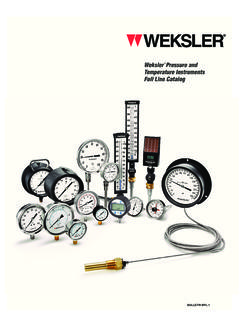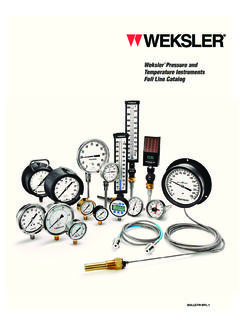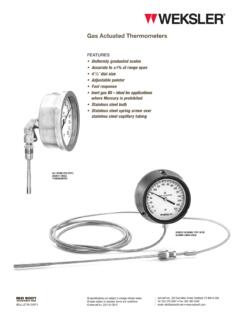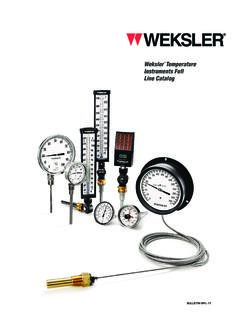Transcription of Weksler Pressure and Temperature Instruments …
1 1 Weksler Pressure and Temperature Instruments Full Line CatalogBULLETIN WFL-121 TABLE OF CONTENTS23 Table of ContentsPAGES electing A Pressure gauge .. 4 Corrosion Chart .. 5 TEST GAUGES Accuracy (TG) .. 6 General Purpose Digital Gauges (DG) .. 7 ROYAL & REGAL GAUGESP rocess Gauges AA ..11-13 Receiver Gauges AR ..14 Industrial Gauges BA ..15-17 Altitude Gauges BM, BN ..18 Refrigeration & Ammonia Gauges BP, BQ ..19 100mm Gauges BA4CY ..20 Duplex Gauges BB ..21 Differential Gauges BC, BD ..22 Reid Vapor Test RV ..23 Bellows Gauges BL ..24 Metric Scales ..25 Case Style & Dimensions ..26-28 gauge ACCESSORIESA ccessories/Options/Tools ..32-33 Snubbers ..34 gauge Cocks, Needle Valves, Siphons ..35 ECONOMY UTILITY GAUGESDry Gauges ..39 Liquid Filled Gauges ..40-41 Contractor Gauges ..42 LINE ASSEMBLIES1115A/1115P Line Assemblies.
2 45 PAGEBIMETAL THERMOMETERSI ntroduction ..49 Adjustable Angle AFCF ..50 3 Dial Size Rigid Forms 3A, 3S ..51 5 Dial Size Rigid Forms 5A, 5S ..52 3 Dial Size Heavy Duty H3A, H3S ..53 Pocket Bimetal IR, 2R, 2T ..54 GLASS THERMOMETERSA djustable Glass Thermometers A735, A935 ..59 Adjustable Air Duct Thermometers D735, D790 ..60 Adjust Angle Digital Thermometers AD35, AD60 ..61 Dimensions, Thermowells ..62 Navy/Marine Thermometers S520, S540 ..63 Economy Glass Thermometers E520L ..63 GAS ACTUATED THERMOMETERSI ntroduction ..67 Remote Mounted Thermometers 313B,413B, 613B ..68 How to Order Remote Gas Actuated Thermometers ..69-70 Econo Gas Actuated Thermometers 313E, 413E, How to Order Econo Gas Actuated Thermometers ..72-73 Case Styles, Materials, Descriptions, Dimensions.
3 74-77 Optional Features ..78 Thermowells ..79 Temperature Conversion Table ..804 Pressure gauge SelectionConsiderations in Selecting a Pressure Gauge4 RANGEThe maximum operating Pressure should not exceed 75% of the full-scale range. The normal operating range should be in the middle half of the range (between 25% and 75% of the full-scale range); whenever SIZES elect a dial size that allows you to comfortably read the dial from the normal distance when SYSTEM MATERIALThe media to which the gauge will be subjected is critical to the selection of the proper material for the Bourdon tube, bellows, and socket. Consult corrosion chart on page 5 for proper selection of Pressure system materials. Weksler models are offered with:Phosphor bronze Bourdon tube (or bellows) with brass stainless steel Bourdon tube (or bellows) with 316 stainless steel stainless steel Bourdon tube with alloy steel Bourdon tubes with Monel applications where the above materials may not be suitable, a diaphragm seal will be necessary to protect the Pressure gauge a gauge with the desired accuracy as follows.
4 1/4% test gauges only (not for in-line service) 1/2% Weksler Royal gauges (41/2 dial size and larger) and Weksler digital gauges (21/2 case size) 1% Weksler Regal gauges, 100 MM gauge , EA14 gauge2-1-2% Weksler duplex, differential and low Pressure gauges3-2-3% Weksler BY12, BY42, UA15, UA20, UA25, UA35 series utility gaugesMOVEMENTS elect either a gauge with 300 series stainless steel movement for long wear or a gauge with bronze or brass movement for applications where vibration and pulsation are not wide variety of case styles and materials are offered. Determine how the gauge is to be mounted: direct, surface (wall) or flush (in panel). Determine the desired case materials: polyproylene (or phenol); aluminum (black enameled) or stainless steel (300 series).
5 WARNING: Misuse, Including Excessive Pressure , Vibration, Pulsation, Tempera-ture And Corrosion May Cause Failure That Can Result in Damage Or suggest that users of Pressure Gauges refer to American National Standard ASME entitled Gauges, Pressure And Vacuum Indicating Dial Type Elastic Element for guidance in gauge selection . This document may be obtained from American Society of Mechanical Engineers (ASME) United Engineering Center, 345 East 47th Street, New York, case type: Safety (solid front with blow-out back)Standard (open front with rubber blow-out disc at rear)Note All safety case styles are designated by a number. Standard case styles are designated by a glass face is standard in most gauges. If breakage is a concern, a plastic or shatterproof glass face is optional at extra cost on most Weksler Royal and Regal gauges.
6 (Glycerin filled and sanitary gauges have plastic face as standard).POINTERAll Weksler gauges (except utility types) have adjustable pointers. This permits pointer repo-sitioning during calibration check or allows maximum precision at a specific ambient Temperature to which the gauge will be subjected should not exceed 150 F. If higher temperatures are encountered the gauge must be isolated from the source of heat. The Temperature of the media to which the gauge is subjected to is also critical. Gauges with phosphor bronze Bourdon tubes should not be subjected to process temperatures in excess of 150 F. Gauges with metal cases and either 316 stainless steel or monel bourdons can withstand higher process temperatures , but as Temperature exceeds 150 F hardening of the gasketing and discoloration of the dial may occur.
7 In addition, accuracy will be affected by approximately per 100 F. Both 316 stainless steel and monel gauges in metal cases will withstand 750 F for short periods of time without rupture, but other parts of the gauge will be destroyed and calibration will be present, a glycerin filled gauge is present, a Pressure snubber or throttle screw is Oil (Sour) Crude Oil (Sweet) Ethyl Acetate Ethylene Oxide >99%* Ferric Chloride <40% Ferric Sulfate <10% Ferrous Chloride <30% Ferrous Sulfate <50% Fluorine Gas (Dry) No Air Formaldehyde <95% Formic Acid* Freons Furfural <10% Gasoline (Flowing) Glycerin >99% Hydrobromic Acid Hydrochloric Acid Hydrofluoric Acid Hydrofluosilic Acid Hydrogen(2) Hydrogen Peroxide <50% Kerosene Lactic Acid <70%*(2) Magnesium Chloride <40% Mercury >99% Milk Naphtha >99% Naphthalene >99% Nickel Chloride >99% Nitric Acid <95%* Nitrogen Oleic Acid Oxalic Acid* Acetone* Acetic Acid <40% Acetic Anhydride Acetylene (Dry) Acrolein 100% Air Alcohol, Ethyl Alum.
8 Chloride >10% Alum. Sulfate 10-50% Ammonia Gas (Dry) Ammonium Chloride <40% Ammonium Nitrate <50% Ammonium Sulfate <60% Aniline>99% Argon Beer Benzidine >99% Benzene <50% Benzoic Acid <70% Boric Acid <25% Bromine (Dry) Butane Butyric Acid <10% Calcium Chloride <80% Calcium Hydroxide <50% Carbon Dioxide Carbon Monoxide (Dry) >99% Chlorine (Dry) Chlorine (Moist) Chloroform (Dry) Chromic Acid Citric Acid 10-50% Corn Oil 5 Corrosion ChartThe media being measured must be compatible with the wetted parts of the Pressure instrument. To use the chart below, locate the media whose Pressure is to be measured and select a suitable material from those available.
9 This is a simplified chart and assumes the media Temperature is below 200 F except for media with an* which must be below 100 F. Throttling devices and/or a liquid filled The primary considerations in specifying or purchasing a Pressure gauge are the accuracy required and the media to be used in its application. This corrosion chart has been prepared to assist you in the selection of the gauge material that is best for your installation are recommended in applications with pulsation or vibration. These recommendations are only a guide, as service life is dependent on Temperature , concentrations, catalysts that may be added, or other conditions beyond our control. Consult customer service for specific applications and for any media not listed.(1) Monel and 316 stainless steel are acceptable for oxygen service, provided the instru-ment has been cleaned for service and is free from oil.
10 Order variation X6B.(2) Over 1000 psi entire system must be 316 stainless *Media Temperature must be below 100 F. ** Any standard Bourdon tube or bellows material may be used in conjunction with a diaphragm seal (with bellows use a Viton or Kalrez diaphragm ), but the gauge selection should take into consideration the corrosive environment in which it is to operate. Table revised June 1st, 2005 Brass or bronzeSteel316 SSMonelDiaphragm seals**Brass or bronzeSteel316 SSMonelDiaphragm seals**Brass or bronzeSteel316 SSMonelDiaphragm seals** Pressure InstrumentMaterialPressure InstrumentMaterialPressure InstrumentMaterialOxygen (Gas)(1) Palmitic Acid >99%* Phosphoric Acid <80%* Picric Acid <10% Propane (Dry) DOT Quality Sea Water (Flowing) Silver Nitrate <70% Sodium Bicarbonate <20% Sodium Bisulfate <30% Sodium Carbonate <40% Sodium Chromate <60% Sodium Cyanide* Sodium Hydroxide < 40% Sodium Hypochlorite <25% Sodium Phosphate,Tri <60% Sodium Silicate <50% Sodium Sulfide <50% Stannous Chloride <10% Steam (Use siphon) Stearic Acid Sulfur Dioxide (Dry) >99% Sulfur Trioxide (Dry) >99% Sulfuric Acid Tannic Acid <80% Tartaric Acid <50% Tin Chloride (ous) <10% Toluene >99% Turpentine >98% Water (tap)




